Click on images to enlarge

infestation (Photo: Land Protection, QDNRW)
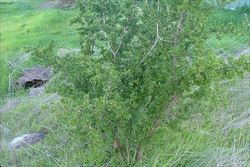
habit (Photo: Sheldon Navie)
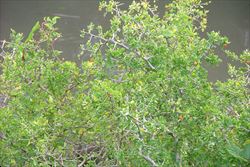
habit (Photo: Sheldon Navie)
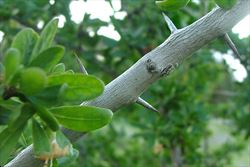
older branch with greyish bark and small spines (Photo: Sheldon Navie)
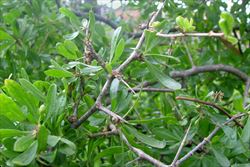
short side-branches ending in spines (Photo: Sheldon Navie)

clustered leaves (Photo: Sheldon Navie)

leaves and flower (Photo: Sheldon Navie)
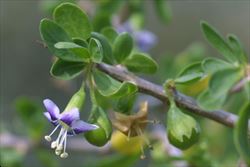
flower and immature fruit (Photo: Trevor James)
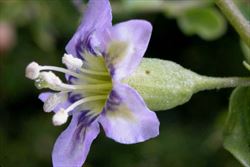
close-up of flower (Photo: Greg Jordan)

mature fruit (Photo: Sheldon Navie)
Scientific Name
Lycium ferocissimum Miers
Synonyms
Lycium europaeum L. (misapplied)Lycium macrocalyx Domin
Family
Solanaceae
Common Names
African boxthorn, box-thorn, boxthorn, Cape boxthorn
Origin
Native to southern Africa (i.e. South Africa).
Naturalised Distribution
Widely naturalised throughout large parts of Australia. It is common and widespread in New South Wales, the ACT, Victoria, Tasmania and South Australia. Common in inland southern Queensland and south-western Australia, and occasionally present in other parts of these states as well as in the southern parts of the Northern Territory. Also naturalised on Lord Howe Island and Norfolk Island.
Habitat
A weed of semi-arid and arid regions and drier sub-tropical and temperate environments. It infests pastures, grasslands, open woodlands, roadsides, railways, disturbed sites, waste areas, coastal environs and inland waterways.
Habit
An upright (i.e. erect) and spiny shrub usually growing 2-3 m tall and about 3 m across, but occasionally reaching up to 6 m in height.
Distinguishing Features
- an upright spiny shrub usually growing 2-3 m tall and spreading about 3 m across.
- large spines (2-15 cm long) are borne along the stems and smaller spines are borne at the ends of short side-branches.
- its hairless leaves are somewhat fleshy and are usually borne in groups of 5-12 at the stem joints.
- its tubular flowers (8-12 mm across) are borne singly or in pairs in the forks of the leaves.
- these flowers are white or pale lilac with darker purple markings, and their petal lobes are bent backwards.
- its egg-shaped or rounded berries (5-12 mm long and 5-10 wide) turn orange-red or bright red in colour when mature.
Stems and Leaves
The stems are light brown and hairless (i.e. glabrous) when young, much-branched, and turn grey or brown and fissured as they mature. Spines up to 15 cm long are borne on the older stems, with much smaller spines on newer growth (about 2 cm long). Each small side-branch also ends in a small spine (about 13 mm long).
The leaves are hairless (i.e. glabrous), slightly fleshy in nature (i.e. semi-succulent), and have entire margins. They are borne on short stalks (i.e. petioles) 1-10 mm long and are either alternately arranged or borne in groups of 5-12 at the stem joints (i.e. nodes). These small leaves (6-40 mm long and 2-20 mm wide) are sometimes egg-shaped in outline (i.e. ovate) to oval (i.e. elliptic) in appearance, but are usually wider near the top and taper towards the base (i.e. obovate).
Flowers and Fruit
The fragrant tubular flowers (8-12 mm across and 10-13 mm long) are borne singly, or in pairs, on short stalks (i.e. pedicels) 5-16 mm long that originate in the leaf forks (i.e. axils). They are white or pale lilac with darker purple markings and have five, or sometimes four, petal lobes. These petals are strongly bent backwards (i.e. reflexed) and surround five prominent stamens. Flowering occurs throughout most of the year, but is most abundant during spring and summer.
The fruit is an egg-shaped (i.e. ovoid) or rounded (i.e. globose) berry turning from green to orange-red or bright red in colour as it matures. These fruit (5-12 mm long and 5-10 mm wide) are smooth and shiny in appearance and partially enclosed in the persistent fused sepals (i.e. calyx). Each fruit contains numerous (20-70) small seeds (2.5 mm long and 1.5 mm wide) that are light brown or yellow in colour and have small raised projections on their surfaces.
Reproduction and Dispersal
This species reproduces mostly by seed, which are commonly dispersed when the fruit are eaten by birds and other animals (e.g. foxes). Seeds may also be spread by water, machinery and in dumped garden waste or contaminated soil. Suckers are sometimes produced from root fragments and shoots may rarely also be produced from stem fragments.
Environmental Impact
African boxthorn (Lycium ferocissimum) is regarded as a significant environmental weed in Victoria, South Australia and Western Australia, and as an environmental weed in New South Wales, the ACT, Queensland, Tasmania and the Northern Territory. It is actively managed by community groups in Tasmania, South Australia and Western Australia and is listed as a priority environmental weed in 17 Natural Resource Management regions.
Other Impacts
The fruit of this species are thought to be poisonous to livestock and humans.
Legislation
This species is declared under legislation in the following states and territories:
- ACT: C2 - a pest plant that must be suppressed, and C4 - prohibited pest plant (a pest plant whose propagation and supply is prohibited).
- New South Wales: Class 4 - a locally controlled weed. The growth and spread of this species must be controlled according to the measures specified in a management plan published by the local control authority and the plant may not be sold, propagated or knowingly distributed (in a large number of local authority areas). See the New South Wales Department of Primary Industries Noxious Weeds List at http://www.dpi.nsw.gov.au for more detailed information on which local areas are covered in these declarations.
- Northern Territory: A - to be eradicated (throughout all of the Territory), and C - not to be introduced into the Territory.
- Queensland: Class 2 - landowners must take all reasonable steps to keep land free of this species (throughout the entire state). It is also illegal to sell a declared plant or its seed in this state.
- South Australia: 2@ - this species is declared under Class 2c(i), which is a classification for statewide pest plants. It is declared, and its control is required, throughout the entire state.
- Tasmania: D - the importation or sale of this species is prohibited and measures to reduce its population in an area, eradicate it from an area, or restrict it to a particular area may be required.
- Victoria: P1 - prohibited and must be eradicated or controlled (in the North East region only), and C10 - all reasonable steps must be taken to control the weed and prevent its spread (in the Mallee, Wimmera, Glenelg, North Central, Corangamite, Port Phillip West, Port Phillip East, Goulburn, West Gippsland and East Gippsland regions).
- Western Australia: Prohibited - on the prohibited species list and not permitted entry into the state.
Management
For information on the management of this species see the following resources:
- the Victorian Department of Primary Industries Landcare Note and Coastal Note on this species, which are both available online at http://www.dpi.vic.gov.au.
- the Biosecurity Queensland Fact Sheet on this species, which is available online at http://www.dpi.qld.gov.au.
- the Northern Territory Department of Natural Resources, Environment and The Arts Agnote on this species, which is available online at http://www.nt.gov.au/weeds.
- the Tasmanian Department of Primary Industries and Water Weed Service Sheet on this species, which is available online at http://www.dpiw.tas.gov.au.
Similar Species
African boxthorn (Lycium ferocissimum) is similar to the native Australian boxthorn (Lycium australe) and other introduced weedy relatives such as Chinese boxthorn (Lycium barbarum). These species can be distinguished by the following differences:
- African boxthorn (Lycium ferocissimum) has small leaves (6-40 mm long and 2-20 mm wide) that are relatively broad and only slightly fleshy. Its relatively large berries (5-10 mm across) are rounded (i.e. globose) or slightly egg-shaped (i.e. ovoid) and contain numerous (30-70) seeds.
- Australian boxthorn (Lycium australe) has very small leaves (3-25 mm long and 1.5-3 mm wide) that are relatively narrow and quite thick and fleshy in nature. Its relatively small berries (2-5 mm across) are oval (i.e. ellipsoid) or egg-shaped (i.e. ovoid) and contain only 5-20 seeds.
- Chinese boxthorn (Lycium barbarum) has small leaves (8-55 mm long and 2-15 mm wide) that are relatively broad and only slightly fleshy. Its relatively small berries (3-4 mm across) are oval (i.e. ellipsoid) or narrowly oval in shape and contain only about 20 seeds.

